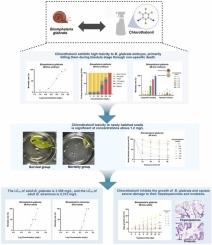百菌清的发育毒性及环境风险评价:以生物phalaria为模型腹足动物的综合研究
IF 11.3
1区 环境科学与生态学
Q1 ENGINEERING, ENVIRONMENTAL
引用次数: 0
摘要
农药污染对水生生态系统的威胁十分严重。百菌清是一种广谱杀菌剂,对非目标生物产生毒性作用。虽然以前的研究主要集中在贻贝、蛤蜊和鱼类上,但对腹足类动物的研究仍然有限,尽管它们具有重要的生态作用。本研究系统评价了百菌清在光斑白僵菌不同发育阶段的毒性,并以白僵菌(红色)成虫作为比较参考。结果表明,光斑白僵菌胚的中位致死浓度为0.3396 mg/L,成虫的中位致死浓度为3.598 mg/L,赤色白僵菌成虫的中位致死浓度为2.315 mg/L。长期暴露于亚致死浓度(21天)可显著抑制蛋壳生长,减少产蛋量,并增加异常卵质量。组织病理学分析显示,在0.8 mg/L浓度下,组织损伤严重,包括血细胞密度降低、肝胰腺腺泡解体和卵睾丸空泡形成。这些发现为百菌清的环境风险提供了重要证据,并强调了评估农药对非目标生物不同发育阶段的影响的重要性。本文章由计算机程序翻译,如有差异,请以英文原文为准。

Developmental Toxicity and Environmental Risk Assessment of Chlorothalonil: A Comprehensive Study Using Biomphalaria as a Model Gastropod
The threat of pesticide pollution to aquatic ecosystems is severe. Chlorothalonil, a broad-spectrum fungicide, causes toxic effects on non-target organisms. While previous studies have focused on mussels, clams, and fish, research on gastropods remains limited despite their critical ecological roles. This study systematically evaluated the toxicity of chlorothalonil across different developmental stages of B. glabrata, with B. straminea (Red) adults serving as a comparative reference. Results showed that the median lethal concentration (LC50) was 0.3396 mg/L for B. glabrata embryos and 3.598 mg/L for adults, while the LC50 for B. straminea (Red) adults was 2.315 mg/L. Chronic exposure (21 days) to sublethal concentrations significantly inhibited shell growth, reduced egg production, and increased abnormal egg masses concentration-dependently. Histopathological analysis revealed severe tissue damage at 0.8 mg/L, including reduced hemocyte density, hepatopancreatic acinar disintegration, and ovotestis vacuolation. These findings provide critical evidence of chlorothalonil’s environmental risks and emphasize the importance of evaluating pesticide effects on different developmental stages of non-target organisms.
求助全文
通过发布文献求助,成功后即可免费获取论文全文。
去求助
来源期刊

Journal of Hazardous Materials
工程技术-工程:环境
CiteScore
25.40
自引率
5.90%
发文量
3059
审稿时长
58 days
期刊介绍:
The Journal of Hazardous Materials serves as a global platform for promoting cutting-edge research in the field of Environmental Science and Engineering. Our publication features a wide range of articles, including full-length research papers, review articles, and perspectives, with the aim of enhancing our understanding of the dangers and risks associated with various materials concerning public health and the environment. It is important to note that the term "environmental contaminants" refers specifically to substances that pose hazardous effects through contamination, while excluding those that do not have such impacts on the environment or human health. Moreover, we emphasize the distinction between wastes and hazardous materials in order to provide further clarity on the scope of the journal. We have a keen interest in exploring specific compounds and microbial agents that have adverse effects on the environment.
 求助内容:
求助内容: 应助结果提醒方式:
应助结果提醒方式:


